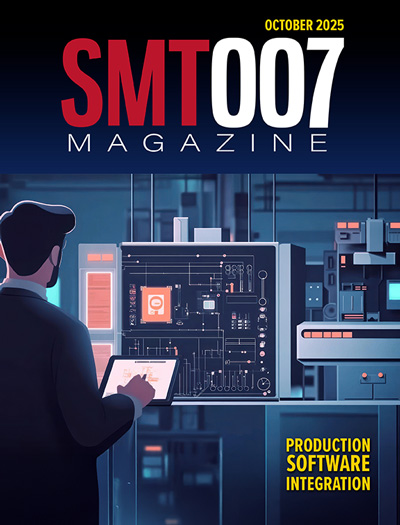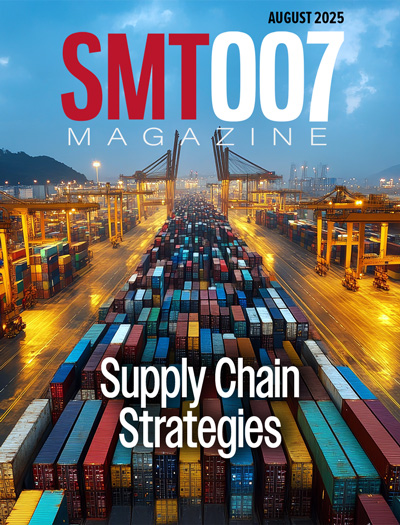-

-
News
News Highlights
- Books
Featured Books
- smt007 Magazine
Latest Issues
Current Issue
Production Software Integration
EMS companies need advanced software systems to thrive and compete. But these systems require significant effort to integrate and deploy. What is the reality, and how can we make it easier for everyone?

Spotlight on India
We invite you on a virtual tour of India’s thriving ecosystem, guided by the Global Electronics Association’s India office staff, who share their insights into the region’s growth and opportunities.

Supply Chain Strategies
A successful brand is built on strong customer relationships—anchored by a well-orchestrated supply chain at its core. This month, we look at how managing your supply chain directly influences customer perception.
- Articles
- Columns
- Links
- Media kit
||| MENU - smt007 Magazine
Book Excerpt: The Electronics Industry’s Guide to… The Evolving PCB NPI Process, Chapter 1
September 28, 2022 | I-Connect007 Editorial TeamEstimated reading time: 2 minutes
Chapter 1
How the NPI Process Has Changed and Where We're Going
When forging into unknown territory or exploring new ground, it can help to look at where we’ve been so we can orient ourselves.
Just a few decades ago, electronics manufacturing companies were producing high volumes of few products. The efficiency of electronics manufacturing lines is measured by overall equipment effectiveness (OEE) and total effective equipment performance (TEEP). Back then, this meant optimizing the time it took to build a single board. If the time it took to build one board could be reduced by a few seconds, the savings would be multiplied by the number of boards being built. This could be in the hundreds of thousands or millions of boards, with no changes in the line configuration. If it took a day to change over from one product to another, it didn’t matter because the TEEP/OEE was driven by the time it took to build a board.
For example, consider that it takes 35 seconds to place components on a single board, and I need to make 250 boards. My handling time (the time it takes to load a board into the machine and get it out after) is 10 seconds, then the total time to build the 250 boards will be (35 + 10) • 250 = 11,250 seconds. This equates to about 188 minutes, or approximately three hours. If it takes four hours to changeover—namely reconfigure the line before starting a different PCB—to a new product, my OEE will be less than 50%, considering no other external factors. As the batch size goes down, the changeover time dominates the OEE figure.
In today’s high-mix, low-volume production environments, performance is further enhanced with line efficiency. Line efficiency is the ratio of the number of hours during which a high-volume, pick-and-place machine places parts on the PCB, divided by the number of hours during which the SMT assembly lines are staffed (placement time/staffed time x 100). It is a solid number, simple to obtain, and has great value as a key performance indicator.
With higher product mixes, the number of NPIs being processed increases. Changeovers on the shop-floor line can happen daily or many times a day. This also means the time it takes to process the source design data has increased. This data-processing time is becoming a more important consideration compared to when NPI processing was not a daily task in the lower mix environment. As product mix has gone up, there has been a move from mixed vendor lines focused on ultimate through-put to single vendor lines focused on flexibility and shorter changeovers. There may be more than one pick-and-place vendor brand in the factory, but each line commonly has only one brand now.
Download your free copy today! You can also view other titles in our full library.
We hope you enjoy The Electronics Industry’s Guide to… The Evolving PCB NPI Process.
Testimonial
"The I-Connect007 team is outstanding—kind, responsive, and a true marketing partner. Their design team created fresh, eye-catching ads, and their editorial support polished our content to let our brand shine. Thank you all! "
Sweeney Ng - CEE PCBSuggested Items
Hon Hai Sales Jump 11% on AI Server Boom, Boosting Nvidia Supply Chain
10/07/2025 | I-Connect007 Editorial TeamNvidia Corp.’s key server production partner, Hon Hai Precision Industry Co., reported an 11% year-on-year rise in quarterly sales on October 5, underscoring sustained global demand for artificial intelligence (AI) infrastructure, Bloomberg reported.
Hardware Engineers, Manufacturing Leaders Ready to ‘Build Better’ Electronics
10/06/2025 | Marcy LaRont, I-Connect007According to Instrumental’s dynamic CEO, Anna-Katrina Shedletsky, the Build Better Electronics Manufacturing Summit on Sept. 30 was a passion project meant to provide a forum for hardware engineering senior leadership, who have very busy jobs and limited opportunities, to share information, thought leadership, and networking opportunities. “Build Better is really about cross-pollination and sharing,” she said, as she highlighted the importance of supporting this type of sharing in tech, which may be more important than ever before.
Taiwan Rejects U.S. Proposal for 50-50 Semiconductor Production Split
10/03/2025 | I-Connect007 Editorial TeamTaiwan stated on October 1 that it will not agree to a U.S. proposal to shift half of its semiconductor production to the United States, despite mounting pressure from Washington over tariffs and chip supply security, according to Reuters.
AT&S Plans Entry Into the Defense Sector
10/02/2025 | AT&SIn times of global uncertainty and geopolitical tension, AT&S is expanding its portfolio to include the defense sector. As a globally leading provider of high-end IC substrates and printed circuit boards, the company is responding to growing demand for security-relevant solutions and emphasizing its social responsibility. This demand will be addressed from its site in Leoben, Austria.
High-Tech Hill Technology Park Opens: Four New Factories Launched
09/26/2025 | TeltonikaThe ambitious vision announced in late 2020 to build a world-class technology park in Liepkalnis, Vilnius, has become a reality. AGP Investments, led by entrepreneur Arvydas Paukštys, together with high-tech leaders Teltonika and TLT, today inaugurated four new factories at the Vilnius High-Tech Hill Technology Park.


